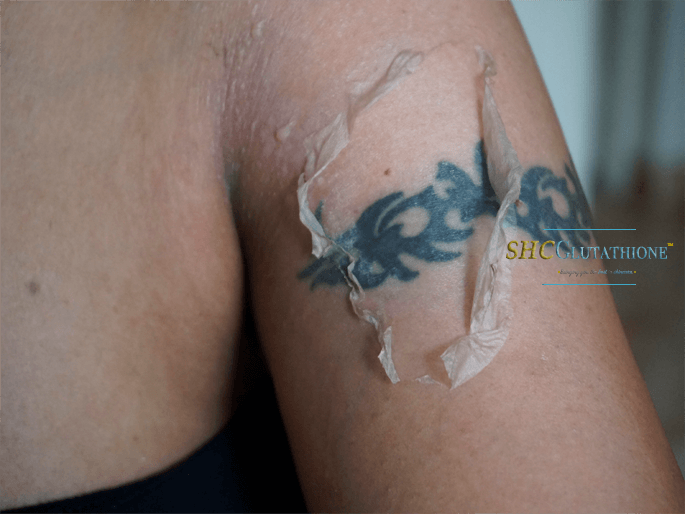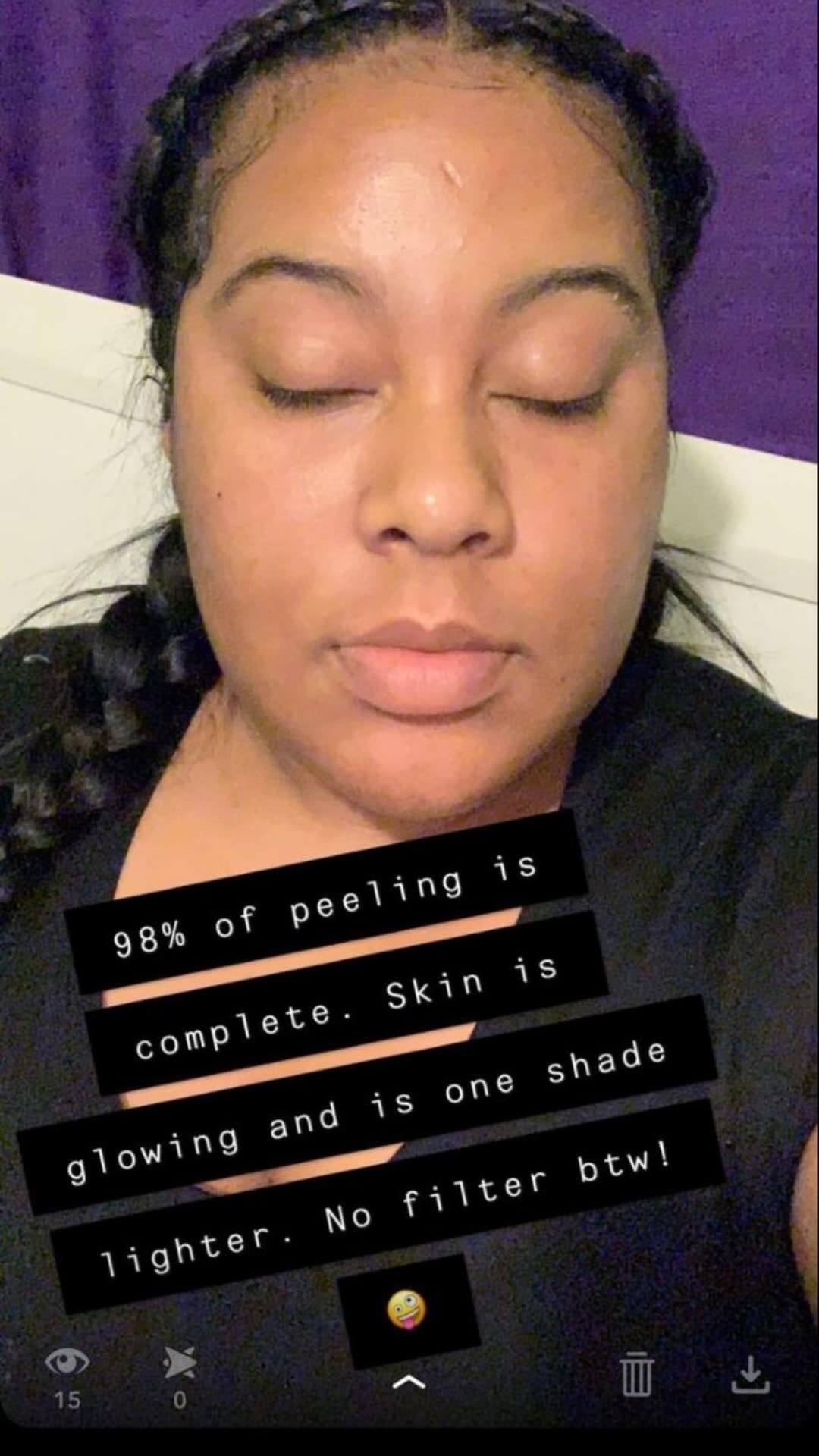
What is the Yellow Peeling Oil?
The Yellow Peeling Oil by The Good Peel is a strong-strength AHA (Alpha Hydroxy Acid) based oil that contains a potent mix of AHA's designed to effectively remove dark marks, hyper-pigmentation, spots, and acne scarring.
As it's a layered peel (meaning it contains more than one peeling agent), it has a stronger effect on the skin than generic AHA peels. It is suitable for use on all skin types. If you have a particular skin condition, such as eczema and dermatitis, we'd advise consulting with your dermatologist before using.
Price
£42.50 per bottle (110ml).
Important (must read)
Avoid conducting a full body peel when starting out. Conduct a peel on one area of the skin (e.g. legs only) at a time, until you are familar with the peeling process. Do not overlook this.
Size (ml)
110ml.
Generally 5 bottles is more than sufficient for the average sized body. You may need more bottles if you have a bigger frame.
What is in the Yellow Peeling Oil?
Active ingredients: Glycolic Acid, Lactic Acid, Malic Acid, Salicylic Acid, Citric Acid, Vitamin A.
Inactive ingredients
Dimethyl Isosorbide, Alcohol Denat, Allantoin, Phenoxyethanol, Ethylhexylglycerin, Aqua, Panthenol, Hydroxypropyl Ethylcellulose, FD&C Red No. 40.
Guidance & Precautions
You should only use this peel if you are familiar with your skin type and you've used AHA products previously with no complications. The extent of the peeling will vary from person to person. To avoid post-peel hyper-pigmentation and achieve a great peel, please follow the instructions below as carefully as possible:
Instructions:
1) Wash and clean the area of your body or face where you wish to apply the peeling oil. Do not apply any scrub or exfoliants a few days prior, as this can aggravate the skin, making it more sensitive.
2) Apply the peeling oil 3x per-day, ideally in the afternoon or evening (every few hours) for at least 3-4 days. Allow the product to fully absorb into the skin before re-applying. Do not apply for more than 4 days. Consider doing this treatment on the weekend or on your days off from work when you are less likely to be disrupted. If you must shower, do so without soap.
3) The peeling process generally begins on the 3rd or 4th day. Once the skin shows signs of superficial peeling, (dry, leathery, shiny, or chapped skin), do not pick the skin. Do not remove the dead layer of skin yourself, let it fall off on its own. You can wash, and bathe as usual but avoid exfoliants during this time.
4) Take care of the new skin layer as much as possible. Soften the dead skin to fall off by washing with warm water and moisturizing heavily. This, will quicken the peeling process.
The skin may be itchy while it's peeling, which is normal and will generally occur as the dead skin layer sheds. If redness occurs, do not touch the skin. Keep the skin as moisturized as possible.
5. Once the peeling process has finished, you can revert to using your natural skin-lightening product as usual. We do not advise using hydroquinone, or steroid-based products. The new skin layer will be hypersensitive and will absorb any product you use. Please bear that in mind.
Pre-cautions - while the skin is peeling:
1. The new skin layer will be hyper-sensitive, so avoid applying skin-lightening products, or AHA-based products. This can lead to irritation and post-peel hyper-pigmentation.
2. Do not scratch or peel the skin.
3. Minimize your exposure to sunlight. Apply sunscreen as much as you can. Zinc/Titanium-based sunscreens offer the highest protection.
4. Only conduct 1 peel every 8-10 weeks.
Overusing the product will do more harm than good.
Application fan brushes are available.
State "request for a fan brush" in your order notes.
Helpful tips
We advise conducting a patch test prior to applying the peeling oil to large areas of skin.
1) The oil should only be applied to clean, dry skin. The skin must be free from bruises and scratches (applying to bruised skin may result in stinging or irritation)
2) Apply the oil using a brush for more even distribution. The application should be even around the skin while avoiding the circles of the mouth, eyes, and inner nostrils.
3) Apply multiple layers of the oil in 20-30 minutes intervals (max. 4x per day) for a deep and faster peel.
4) Do not wash the skin for at least 3 days if you'd like your skin to peel at a quicker rate. If this isn't possible, you can bath with a mild soap and water. This allows the solution to penetrate the deeper layers of the skin.
5) You can apply a whitening lotion or cream after 3-4 days of peeling or once the skin has healed.
6) Avoid direct sunlight while the skin is peeling, if redness occurs, allow the skin to heal and do not reapply to that area.


Pre-Peel Care
- Discontinue the use of chemical exfoliants at least 1 week before conducting a chemical peel, including the use of Retinoids, AHA, and BHA based products. - Discontinue the use of a tanning bed, and waxing at least 7-10 days before using this peeling agent. - Avoid excessive heat and limit all sun-exposure, and avoid the gym at least 24-48 hours before using the peeling oil - as this elevates the body temperature. - Avoid manual exfoliants such as loofahs, exfoliating gloves, etc at least 24-48 hours before conducting a peel. - Avoid applying make up on the day of your peel to give the skin some time to stabilize.
The ideal skin condition for a peel is clean, a little dry (not too much), with no open wounds or visible bruising.
Do not apply on damaged skin that has not yet healed.
Post-Peel Care
- Do not pick or peel at the peeling skin. If done so, this will result in post-peel hyperpigmentation. For the best results, allow the skin to fall off by itself. The dead skin layer acts as a protective layer for the skin underneath. Allowing it to fall off naturally is the best. - Wash and bathe as usual only after the application period. For an even peel do not allow water to touch the surface of the skin during the application period of 3-4 days. Otherwise, you may experience a blotchy peel (i.e deeper in certain areas and not in others) You can very lightly scrub the skin to slough away any hanging dead layers of skin while showering, however, avoid any rigorous touching or rubbing. - During the first 7-10 days after the peel do not use any chemical exfoliants, exfoliating soaps, tanning beds, exfoliating products, and avoid fragrances (if possible). Do not have electrolysis, facial waxing, or use depilatories for the first 7 days post peel. Keep the skin well-hydrated and moisturized using a mild moisturizer, such as a glycerin-based product to lock and seal in moisture. Apply petroleum jelly, or CeraVe when necessary. Do not allow the skin to remain dry for long. Epsom and magnesium salt baths will help to loosen the dead skin layer, so consider incorporating a few baths during the process.
After the peeling process is completed follow up with a skin lightening lotion of your choice. Your lotions and potions will absorb into the new skin layer almost instantly. This is both a good thing and a bad thing. The new skin layer is sensitive and prone to post-peel hyperpigmentation if not taken care of. Avoid all AHA based products for at least 1 full week, and do not undergo another peel for another 6-8 weeks.
Guidance and instructions are listed here for a reason. Follow them. Following proper pre-peel and post-peel care instructions are crucial to seeing desirable results from a chemical peel.
Bear in mind...
...skin thickness and skin sensitivity when using our body peels. The thickness of the skin varies throughout the body and understanding areas of the body where the skin is thinner and therefore more likely to react to an acidic product is important.
Be cautious when applying the oil to the following areas of the body (these are characterised as thin, moist areas of the body that are prone to friction and frequent movement): Underarms, back of the knees, folds (anywhere on the body such as the breast fold, abdomen etc.), face and neck, inner thighs, and the anal region. Thicker areas of the body include skin on the legs, outer arms, back and lower back, hands, buttocks, knuckles and feet.
Any product containing AHAs will react very quickly when applied to thinner areas of the skin. Therefore, we recommend applying no more than 1 or 2 applications of our body peeling oil to those areas to avoid any adverse reactions.
Can the Yellow Peeling Oil solve my hyper-pigmentation?
→ Yes, it certainly can. As it's a superficial peeling oil, there is very little chance of post-peel hyper-pigmentation (known as PIH) occurring as a result of the peel (unless overused or used improperly - please refer to the instructions above). The Yellow Peeling Oil is a much safer option compared to a chemical peel as it does not need to be neutralised. The product stays on the skin, and absorbs into the skin over a number of days. The skin typically peels in sheets, and there may be some short down-time involved.
The Yellow Peeling Oil is ideal for those with epidermal layer hyper-pigmentation (brown hyper-pigmentation), dark spots, and acne scarring. It can help to remove years of dark spots and hyper-pigmentation within a few sessions of peeling. It is not ideal for those with dermal layer hyper-pigmentation, which is deeper and of a blue-black color.
Can the Yellow Peeling Oil remove old scars?
→ IIt can remove old scars, depending on the extent of the scarring, and how deep the scarred tissue is. By peeling the surface layers of the skin, the skin is forced to regenerate new skin tissue and new collagen. This results in a diminishing of old scars, dark marks, and layers of dead skin. Regular skin peeling through chemical exfoliants is a great way to achieve a more youthful glow, more radiant skin and to allow the skin to remain younger and firmer for longer. For individuals using skin-lightening treatments, such as Glutathione, superficial skin peeling is essential to revealing lighter, clearer skin.
Before & Afters






Get Email Exclusive Discounts
(Spam? Nope. we play by the rules)
Disclaimer: Products sold by SHCGlutathione and Co. or it's accredited distributors are not intended to diagnose, treat, cure or prevent disease.
Find out more about how the FDA supports and regulates the sale of supplements. Learn more.
© 2023 - 2025 SHCGlutathione. All rights reserved.

